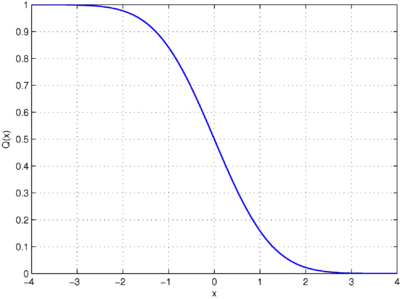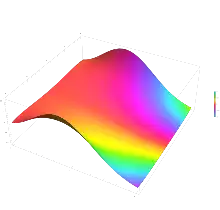
In statistics, the Q-function is the tail distribution function of the standard normal distribution.[1][2] In other words, is the probability that a normal (Gaussian) random variable will obtain a value larger than standard deviations. Equivalently, is the probability that a standard normal random variable takes a value larger than .
If is a Gaussian random variable with mean and variance , then is standard normal and
where .
Other definitions of the Q-function, all of which are simple transformations of the normal cumulative distribution function, are also used occasionally.[3]
Because of its relation to the cumulative distribution function of the normal distribution, the Q-function can also be expressed in terms of the error function, which is an important function in applied mathematics and physics.
Definition and basic properties
Formally, the Q-function is defined as
Thus,
where is the cumulative distribution function of the standard normal Gaussian distribution.
The Q-function can be expressed in terms of the error function, or the complementary error function, as[2]
An alternative form of the Q-function known as Craig's formula, after its discoverer, is expressed as:[4]
This expression is valid only for positive values of x, but it can be used in conjunction with Q(x) = 1 − Q(−x) to obtain Q(x) for negative values. This form is advantageous in that the range of integration is fixed and finite.
Craig's formula was later extended by Behnad (2020)[5] for the Q-function of the sum of two non-negative variables, as follows:
 the Q-function plotted in the complex plane
the Q-function plotted in the complex plane
Bounds and approximations
- The Q-function is not an elementary function. However, it can be upper and lower bounded as,[6][7]
- where is the density function of the standard normal distribution, and the bounds become increasingly tight for large x.
- Using the substitution v =u2/2, the upper bound is derived as follows:
- Similarly, using and the quotient rule,
- Solving for Q(x) provides the lower bound.
- The geometric mean of the upper and lower bound gives a suitable approximation for :
- Tighter bounds and approximations of can also be obtained by optimizing the following expression [7]
- For , the best upper bound is given by and with maximum absolute relative error of 0.44%. Likewise, the best approximation is given by and with maximum absolute relative error of 0.27%. Finally, the best lower bound is given by and with maximum absolute relative error of 1.17%.
- The Chernoff bound of the Q-function is
- Improved exponential bounds and a pure exponential approximation are [8]
- The above were generalized by Tanash & Riihonen (2020),[9] who showed that can be accurately approximated or bounded by
- In particular, they presented a systematic methodology to solve the numerical coefficients that yield a minimax approximation or bound: , , or for . With the example coefficients tabulated in the paper for , the relative and absolute approximation errors are less than and , respectively. The coefficients for many variations of the exponential approximations and bounds up to have been released to open access as a comprehensive dataset.[10]
- Another approximation of for is given by Karagiannidis & Lioumpas (2007)[11] who showed for the appropriate choice of parameters that
- The absolute error between and over the range is minimized by evaluating
- Using and numerically integrating, they found the minimum error occurred when which gave a good approximation for
- Substituting these values and using the relationship between and from above gives
- Alternative coefficients are also available for the above 'Karagiannidis–Lioumpas approximation' for tailoring accuracy for a specific application or transforming it into a tight bound.[12]
- A tighter and more tractable approximation of for positive arguments is given by López-Benítez & Casadevall (2011)[13] based on a second-order exponential function:
- The fitting coefficients can be optimized over any desired range of arguments in order to minimize the sum of square errors (, , for ) or minimize the maximum absolute error (, , for ). This approximation offers some benefits such as a good trade-off between accuracy and analytical tractability (for example, the extension to any arbitrary power of is trivial and does not alter the algebraic form of the approximation).
Inverse Q
The inverse Q-function can be related to the inverse error functions:
The function finds application in digital communications. It is usually expressed in dB and generally called Q-factor:
where y is the bit-error rate (BER) of the digitally modulated signal under analysis. For instance, for QPSK in additive white Gaussian noise, the Q-factor defined above coincides with the value in dB of the signal to noise ratio that yields a bit error rate equal to y.

Values
The Q-function is well tabulated and can be computed directly in most of the mathematical software packages such as R and those available in Python, MATLAB and Mathematica. Some values of the Q-function are given below for reference.
|
|
|
|
Generalization to high dimensions
The Q-function can be generalized to higher dimensions:[14]
where follows the multivariate normal distribution with covariance and the threshold is of the form for some positive vector and positive constant . As in the one dimensional case, there is no simple analytical formula for the Q-function. Nevertheless, the Q-function can be approximated arbitrarily well as becomes larger and larger.[15][16]
References
- ↑ The Q-function, from cnx.org
- 1 2 Basic properties of the Q-function Archived March 25, 2009, at the Wayback Machine
- ↑ Normal Distribution Function – from Wolfram MathWorld
- ↑ Craig, J.W. (1991). "A new, simple and exact result for calculating the probability of error for two-dimensional signal constellations" (PDF). MILCOM 91 - Conference record. pp. 571–575. doi:10.1109/MILCOM.1991.258319. ISBN 0-87942-691-8. S2CID 16034807.
- ↑ Behnad, Aydin (2020). "A Novel Extension to Craig's Q-Function Formula and Its Application in Dual-Branch EGC Performance Analysis". IEEE Transactions on Communications. 68 (7): 4117–4125. doi:10.1109/TCOMM.2020.2986209. S2CID 216500014.
- ↑ Gordon, R.D. (1941). "Values of Mills' ratio of area to bounding ordinate and of the normal probability integral for large values of the argument". Ann. Math. Stat. 12: 364–366.
- 1 2 Borjesson, P.; Sundberg, C.-E. (1979). "Simple Approximations of the Error Function Q(x) for Communications Applications". IEEE Transactions on Communications. 27 (3): 639–643. doi:10.1109/TCOM.1979.1094433.
- ↑ Chiani, M.; Dardari, D.; Simon, M.K. (2003). "New exponential bounds and approximations for the computation of error probability in fading channels" (PDF). IEEE Transactions on Wireless Communications. 24 (5): 840–845. doi:10.1109/TWC.2003.814350.
- ↑ Tanash, I.M.; Riihonen, T. (2020). "Global minimax approximations and bounds for the Gaussian Q-function by sums of exponentials". IEEE Transactions on Communications. 68 (10): 6514–6524. arXiv:2007.06939. doi:10.1109/TCOMM.2020.3006902. S2CID 220514754.
- ↑ Tanash, I.M.; Riihonen, T. (2020). "Coefficients for Global Minimax Approximations and Bounds for the Gaussian Q-Function by Sums of Exponentials [Data set]". Zenodo. doi:10.5281/zenodo.4112978.
- ↑ Karagiannidis, George; Lioumpas, Athanasios (2007). "An Improved Approximation for the Gaussian Q-Function" (PDF). IEEE Communications Letters. 11 (8): 644–646. doi:10.1109/LCOMM.2007.070470. S2CID 4043576.
- ↑ Tanash, I.M.; Riihonen, T. (2021). "Improved coefficients for the Karagiannidis–Lioumpas approximations and bounds to the Gaussian Q-function". IEEE Communications Letters. 25 (5): 1468–1471. arXiv:2101.07631. doi:10.1109/LCOMM.2021.3052257. S2CID 231639206.
- ↑ Lopez-Benitez, Miguel; Casadevall, Fernando (2011). "Versatile, Accurate, and Analytically Tractable Approximation for the Gaussian Q-Function" (PDF). IEEE Transactions on Communications. 59 (4): 917–922. doi:10.1109/TCOMM.2011.012711.100105. S2CID 1145101.
- ↑ Savage, I. R. (1962). "Mills ratio for multivariate normal distributions". Journal of Research of the National Bureau of Standards Section B. 66 (3): 93–96. doi:10.6028/jres.066B.011. Zbl 0105.12601.
- ↑ Botev, Z. I. (2016). "The normal law under linear restrictions: simulation and estimation via minimax tilting". Journal of the Royal Statistical Society, Series B. 79: 125–148. arXiv:1603.04166. Bibcode:2016arXiv160304166B. doi:10.1111/rssb.12162. S2CID 88515228.
- ↑ Botev, Z. I.; Mackinlay, D.; Chen, Y.-L. (2017). "Logarithmically efficient estimation of the tail of the multivariate normal distribution". 2017 Winter Simulation Conference (WSC). IEEE. pp. 1903–191. doi:10.1109/WSC.2017.8247926. ISBN 978-1-5386-3428-8. S2CID 4626481.